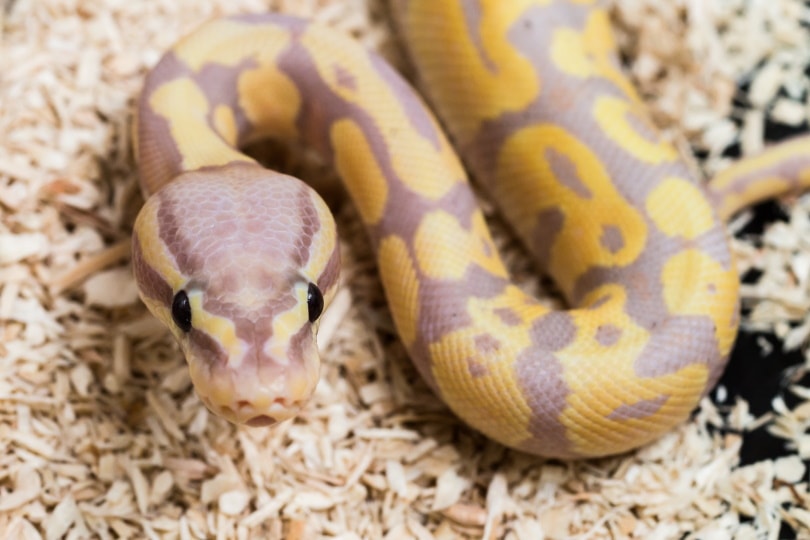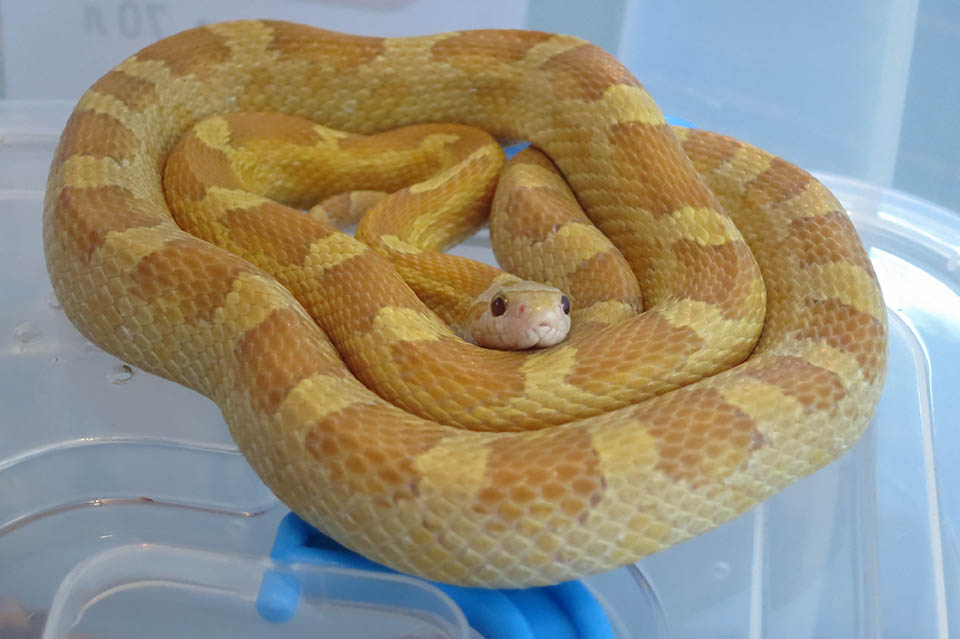
The Nelson’s Milk Snake is one of the most iconic snakes around. You can easily recognize them, even from a distance, due to their colors and patterning. Hardy and attractive, they’re popular pets with low maintenance requirements and relatively easy care that can live for up to 20 years in captivity if you follow the guidelines in this article.
Quick Facts about Nelson’s Milk Snakes
| Species Name: | Lampropeltis Triangulum Nelsoni |
| Common Name: | Nelson’s Milk Snake |
| Care Level: | Low-moderate |
| Lifespan: | 12-20 years |
| Adult Size: | 15-70 inches |
| Diet: | Carnivorous |
| Minimum Tank Size: | 30 gallons |
| Temperature & Humidity: | 70-90 degrees with 40%-60% humidity |
Do Nelson’s Milk Snakes Make Good Pets?
If you’re looking for a cuddly pet to accompany you on your morning run, then a Nelson’s Milk Snake is probably not the pet you’re looking for. On the other hand, if you’re hoping for an interesting pet that you can observe, feed, care for, and occasionally handle, then these snakes are a great option. They have minimal care needs, and since they’re rather resilient snakes, they have few health problems to concern you. As long as you have the right expectations, Nelson’s Milk Snakes can make excellent pets.
Appearance
Nelson’s Milk Snakes look quite similar to the extremely poisonous and deadly coral snake, only their colors are in a different order. “If red touches yellow, you’re a dead fellow. If red touches black, you’re ok Jack,” as the saying goes. These milk snakes have touching red and black bands most often, helping to distinguish them from the aforementioned coral snake, which has touching red and yellow bands instead. Depending on the subspecies, the Nelson’s Milk Snake could be just over a foot long as an adult, or it could be nearly six feet!
How to Take Care of a Nelson’s Milk Snake
Habitat, Tank Conditions & Setup
Tank
Similar to most reptiles, Nelson’s Milk Snakes are usually kept in a glass terrarium with a screen lid, though you can really keep one of these snakes in any type of enclosure, provided there’s adequate ventilation. You’ll need to keep the enclosure clean and sanitary though, which means removing your snake and emptying the tank once each month to clean and disinfect. Spot cleanings should also be performed daily to keep the mess down to a minimum.
Lighting
Nelson’s Milk Snakes are nocturnal, so they don’t require much in the way of lighting. You’ll still want to provide lighting on a standard schedule to mimic daylight hours, but you don’t need any special UVA or UVB bulbs.
Heating (Temperature & Humidity)
As with all snakes, you’ll need to provide a temperature gradient for your milk snake, allowing it to regulate its body temperature. On the warmer side of the enclosure, temperatures should be around 90 degrees, with the cool side remaining around 70. Humidity levels should remain between 40%-60%, which is about the average humidity of most households anyway.
Substrate
Milk snakes like to burrow, so you’ll want to provide several inches of substrate that’s loosely packed. There are several options, including mulch, sand and soil mixtures, or orchid bark, but coconut fiber tends to be one of the best choices.
Tank Recommendations
| Tank Type: | 30-gallon glass vivarium or larger |
| Lighting: | Basic lighting |
| Heating: | Heating pad on bottom of enclosure |
| Best Substrate: | Coconut fiber |

Feeding Your Nelson’s Milk Snake
In the wild, Nelson’s Milk Snakes will eat a variety of small animals, including rodents, small mammals, lizards, and other snakes. For milk snakes in captivity, frozen mice tend to be the best choice as they’re readily available and provide adequate nutrition. It is not recommended to offer live mice to your snake unless you first incapacitate them so they can’t hurt your snake. Instead, you’ll have to thaw frozen mice. Baby milk snakes will feed on pinkies, but the size of feeders should increase along with your snake. Large adults may need to switch to rats when they’re fully mature.
Diet Summary
| Fruits: | 0% of diet |
| Insects: | 0% of diet |
| Meat: | 100% of diet – small/medium-sized rodents |
| Supplements Required: | N/A |
Keeping Your Nelson’s Milk Snake Healthy
Nelson’s Milk Snakes are rather resilient reptiles, so, if proper care is provided, yours may never experience any health problems. However, if living conditions aren’t upheld, then your snake is at risk for developing adverse health conditions. The best way to keep your snake healthy is to ensure its environment is clean and the temperature and humidity levels are sufficient.
Common Health Issues
Lifespan
In the wild, most milk snakes will only live to around 10 years of age, but in captivity, they can live much longer. Granted, your snake’s lifespan is largely dependent on the quality of care you provide, but with sufficient care, your milk snake could live up to 20 years.
Breeding
Nelson’s Milk Snakes are surprisingly simple to breed. Essentially, you just have to house a female and male together. So long as they’re both sexually mature, they’ll do the rest of the work for you. Usually, they mate in the spring, between March and May. This species reaches sexual maturity around three years of age, so it is best not to attempt breeding until your snakes are at least three.
Are Nelson’s Milk Snakes Friendly? Our Handling Advice
Not all snakes are good candidates for handling. Nelson’s Milk Snakes tend to be a bit timider than many other popular pet snakes. They’re also quite active. Together, these make them harder to handle, but they’re still quite handleable snakes overall. You just need to be aware that it will likely try to get away at first. Over time, your milk snake should get used to handling if you do it often enough.
Shedding & Brumation: What to Expect
When your milk snake is young, it will shed frequently, but shedding will occur less with age. If your snake seems to have trouble shedding, try raising the humidity in its habitat.
Reptiles go through a semi-hibernation in the winter known as brumation. In captivity, your milk snake may not brumate unless you lower the temperatures in its cage during the winter months. You don’t need to do this though, unless you plan to breed your snakes. It is generally recommended to brumate a snake before breeding, but otherwise, it’s unnecessary.
How Much Do Nelson’s Milk Snakes Cost?
If you’re looking for an affordable snake to make your pet, then the Nelson’s Milk Snake is a great choice. These snakes are relatively inexpensive, generally falling between $50 and $100. Specimens with exquisite coloration such as albinos can cost more, but average specimens shouldn’t be over $100.
Care Guide Summary
Final Thoughts
Nelson’s Milk Snakes aren’t the most exotic of pets, but they’re easy to keep and make a great first reptile for any snake enthusiast. While they’re a bit harder to handle than some snake species, with regular handling, your milk snake should become agreeable towards handling. They can live for up to 20 years in captivity, providing a great return on a relatively inexpensive investment. Just be sure you’re prepared for a 20-year commitment!
You May Also Like:
- Coral Snake vs. Milk Snake: What’s The Difference? (With Pictures)
- Black Milk Snake: Facts, Info, Pictures & Care Guide
Featured Image Credit: Nelson’s Milksnake, Devin Bergquist, Flicker, Attribution CC 2.0







